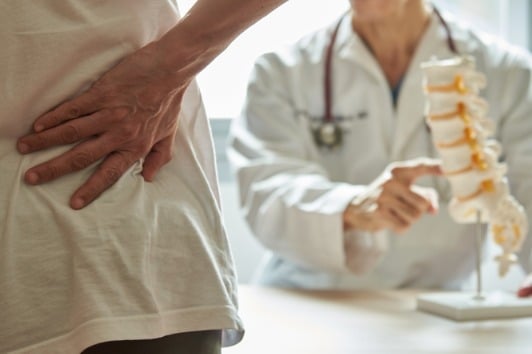
Give Your Low Back Pain A Name: 3 Most Common Low Back Conditions Explained
Experts estimate that up to 80% of the population will suffer from back pain at some point in their lives. That’s an incredibly high number! Back pain is also the third most common reason for visits to the doctor, yet many don’t know when to seek out the care of a spine specialist. In addition, there are many individuals who don’t fully understand the root cause of their symptoms.
These are the three most common low back conditions:
1) Disc Degeneration
2) Spinal Stenosis (Neural Compression)
3) Sacroiliac Joint (SI) / Myofascial Pain
Disc Degeneration:
Low back pain is commonly a result of disc degeneration in the lumbar spine. Cartilage wear and tear happens to all of us each day that we are alive and live under the heavy weight of gravity. In the spine, the bones that support our bodies (vertebral column) are separated by a thick cushion of cartilage called the disc, which provides support and movement. Genetics play a large role in determining the age at which our discs start to deteriorate and how fast they degenerate over the course of our lives. Additionally, our activity level and how much we use our discs adds to the genetic trajectory. The higher the impact and force, particularly in a repetitive fashion, the more likely this will speed up the degenerative process.
On the other hand, complete inactivity, weight gain, poor flexibility and improper body mechanics can be just as harmful in wearing out the discs. What’s worse in this scenario is that pain seems to be less tolerated making treatments less successful.
Lastly, the most detrimental factor for discs is nicotine in any form (smoking, vaping, chewing tobacco, etc). Nicotine kills the oxygen and nutrient supply to the discs wearing them out at an exponential rate. Patients are often surprised by this information, but are glad that removing nicotine use can be the very best way to change their future.
The description of low back pain caused by disc degeneration is similar in most patients.The pain is worse with prolonged positions particularly sitting, long car rides, repetitive bending or prolonged bending such as gardening or cleaning the bathtub. These patients will feel some improvements with lying down and extending their back for a good stretch. If this sounds like you, but you don’t think the symptoms are “bad enough” to seek expert care with a spine specialist, think again!
Seeing a spine specialist is so important as early as possible. At VSI, our goal is to focus our treatments on non-operative care particularly if disc degeneration is the main diagnosis. That goal is often achieved by empowering our patients with a better understanding of why they hurt and arming them with the tools to achieve success through fitness and conditioning with a proper rehab program designed for each individual. We provide our patients with plenty of treatment options and help them arrive at the one that is best suited for their condition. When presenting patients with non-operative treatment solutions, we like to discuss the latest alternatives to surgery in the form of regenerative medicine. These outpatient procedures utilize the body’s healing power to repair damaged tissue, improve pain and further the success of fitness and conditioning over many years to decades.
Spinal Stenosis (Neural Compression)
Spinal stenosis is narrowing around the nerves which can occur when the structures surrounding the nerves are wearing out. This can be due to disc bulging, disc herniation, joint enlargement, ligament thickening or some combination. This narrowing can affect one nerve, multiple nerves or the entire canal of nerves in the middle. If one nerve is pinched, there is often radiating pain down one leg in a particular pattern (the back of the thigh and the calf for example). If multiple nerves are pinched or narrowed, then the pattern can be more diffuse (the outside and back of the thigh, calf, top and bottom of the foot). These patients experience increased symptoms when the pinched nerve is stretched (ie: bending over to touch the toes without bending the knees). If there is stenosis surrounding the large canal of nerves in the center of the spine, then patients often describe buttock and leg pain with standing and walking, which is quickly relieved with sitting and partially relieved with bending.
No matter where the nerves are pinched, patients often describe nerve pain as being severe and unlike any other pain they’ve experienced. Although surgical intervention can be effective to relieve the pressure from the nerves, we can often improve or resolve symptoms with an injection and physical therapy to include traction. The sooner you see a spine specialist will increase the likelihood of resolving the pain with non-operative treatment. Don’t delay prompt evaluation in this case!
Sacroiliac Joint (SI) / Myofascial Pain
There are many joints in and around the spine that can cause back pain. There are two facet joints associated with each disc that can wear out and cause back pain. This type of pain is often made worse by extending the back and might improve with bending forward. The sacroiliac (SI) joints are often sources of low back pain which can involve one or both sides. This joint connects the sacrum to the pelvis, is very large, and can become inflamed and painful. There can be restriction (too little motion) or hypermobility (too much motion) of the SI joints. If you have a lumbar spine issue, the SI joints can be a common place to manifest pain even though the SI joints are not abnormal themselves. SI joints can also become inflamed by a simple fall such as during ice skating or skiing. They can become inflamed during or after pregnancy as the pelvis expands to make room for the baby and then contracts after delivery. A spine specialized physical therapist (such as our team at VSI Physical Therapy) trained in manual manipulation and dry needling can be very successful at resolving SI related pain.
Thao Allen, Physician Assistant at VSI, describes her experience with SI joint pain:
“I personally have first hand experience with SI pain which occurred during my first pregnancy. After delivery, the pain became much worse. I was having difficulty with lifting the baby in the infant carrier and in and out of the crib. Even just a mild bend forward at the sink to brush my teeth was quite painful. To gain some pain relief, I scheduled a physical therapy evaluation with Larry Grine at VSI Physical Therapy. It was amazing! After the evaluation, he diagnosed SI restriction. I laid down on the examination table and he forcefully pulled my leg which manipulated the SI joint back into place. I had immediate relief and was so thankful! I could finally care for my baby without pain.”
In terms of myofascial pain, this is more superficial and affects the muscles and connective tissues. This is typically a place we can press on and reproduce symptoms. If a joint deep to the muscle or fascia is restricted and inflamed, then both will need to be treated to improve pain. Physical therapy is key in these cases. If you’ve had physical therapy, but never had dry needling, then you really should consider spine-specialized physical therapy to experience the benefits of this powerful technique to relieve muscle knots. Don’t shy away from the word needle, as these are just tiny acupuncture needles and are very well tolerated by most patients!
If any of these descriptions sound like you, seek the care of a spine specialist with a dedication in both non-operative and operative spine treatments. In most cases we can identify the problem and suggest the proper rehab facility for physical therapy and athletic training which many times relieves symptoms and improves daily function to prevent future issues. This needs to be tailored to each patient by taking into consideration their pathology, their current fitness level and their desired activities and goals.
Topics covered
About the Author
Featured Resources
Insights to Achieve a Pain-Free Life


